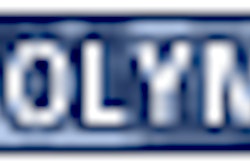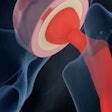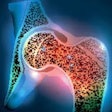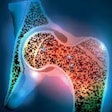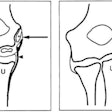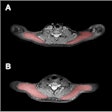
Ottawa Senators forward Magnus Arvedson and Vancouver Canucks goalie Dan Cloutier are among the NHL players who have suffered groin injuries so far during the 2001-2002 season.
"The problem with a groin injury is people don’t see you walking around on crutches and they don’t think you’re hurt," Arvedson told The Sporting News in October 2001. "I don’t have to prove that to anybody here. I know that I’m being criticized for being injured all the time. I’ve heard it from people, but there is nothing I can do."
And short of surgery, there is often no way for a physician to know what to do help a player in Arvedson’s situation.
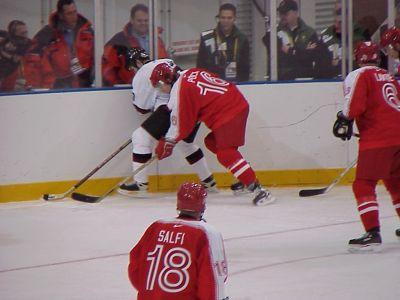 |
| PROVO, UT - A member of the Austrian Olympic hockey team (in red) places a hard check on a Latvian player at Peaks Ice Arena during the 2002 Olympic Winter Games. |
Groin and lower abdominal injuries in hockey players are quite common. In fact, nearly 20% of players experience such injuries during their careers. The injuries are painful, but more frustrating for athletes and the medical community is this: diagnosing an external oblique tear or the entrapment of the ilioinguinal nerve is tricky.
"That’s a very good question, and I don’t have the answer," said Montreal Canadiens team physician Dr. David Mulder when asked why imaging is ineffective in diagnosing some groin and lower abdominal injuries. "The only imaging that we think is useful is bone scanning, and that’s because it rules out osteosis puba. MRI or computed tomography are very useless unless (the injury) is advanced and there is a hematoma."
Mulder, who is a thoracic surgeon in the department of surgery at Montreal’s McGill University, has done several studies about the diagnosis and therapeutic challenges of groin and lower abdominal injuries.
An article published in January 1998 detailed the testing of 11 NHL players who "suffered from atypical refractory pain and paraesthes of the lower abdomen." The study revealed that, "despite use of conventional investigation procedures such as physical examination, ultrasound, bone computed tomography scan and magnetic resonance imaging scan, preoperative findings were consistently negative" (Clinical Journal of Sports Medicine, Vol. 8:1, pp. 5-9).
But, in every case, when surgery was performed, doctors found "varying degrees of tearing of the external oblique aponeurosis and external oblique muscle associated with ilioinguinal nerve entrapment," according to the article.
Since that study was published, Mulder said he has learned that ultrasound and bone scans are helpful in ruling out other injuries. An ultrasound, he said, may show a bulge in the injured area, which is helpful in diagnosis. But in general, imaging is used to rule out injuries such as hernias, osteosis pubis, injuries to the rectus muscle, and injuries to the large adductor magnus muscle. Mulder said that, including the 1998 study, he and his colleagues have examined 100 NHL players with groin or lower abdomen pain.
"The important thing is that we like to rule things out," Mulder said. "All of these things have to be sorted out before we recommend surgery."
A study of 22 hockey players published in October 2001 shed no more light on diagnostic techniques, but did reveal that, upon operating, "all patients had tearing of the external oblique aponeurosis, which branches off the ilioinguinal nerve emerging from torn areas." The described injury is referred to as "hockey groin syndrome," and 82% of the players operated on reported no pain in a follow-up. All players returned to the game (Surgery, Vol. 130: 4, pp. 759-66).
But as before, the injuries were not apparent before surgery when imaging techniques were used.
"These are typically tough diagnoses," said Dr. Michael Fredericson, director of sports medicine clinics in the department of functional restoration at Stanford University in Stanford, CA. "They (patients) can’t always tell you exactly where the pain is."
By Jill R. Dorson
AuntMinnie.com contributing writer
February 11, 2002
To view the rest of AuntMinnie’s coverage of the 2002 Olympic Winter Games, go to http://olympics.auntminnie.com.
Copyright © 2002 AuntMinnie.com




